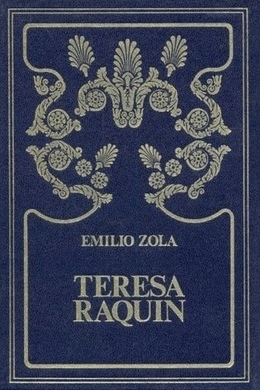
-
EPUB 279 KB
-
Kindle 342 KB
-
Support epubBooks by making a small $2.99 PayPal donation purchase.
Description
One of Zola’s most famous realistic novels, Therese Raquin is a clinically observed, sinister tale of adultery and murder among the lower classes in nineteenth-century Parisian society. Set in the claustrophobic atmosphere of a dingy haberdasher’s shop in the passage du Pont-Neuf in Paris, this powerful novel tells how the heroine and her lover, Laurent, kill her husband, Camille, but are subsequently haunted by visions of the dead man and prevented from enjoying the fruits of their crime. Zola’s shocking tale dispassionately dissects the motivations of his characters–mere “human beasts”, who kill in order to satisfy their lust–and stands as a key manifesto of the French Naturalist movement, of which the author was the founding father. Published in 1867, this is Zola’s most important work before the Rougon-Macquart series and introduces many of the themes that can be traced through the later novel cycle.
283 pages with a reading time of ~4.50 hours (70923 words), and first published in 1867. This DRM-Free edition published by epubBooks, 2015.
Community Reviews
There are currently no other reviews for this book.
Excerpt
At the end of the Rue Guenegaud, coming from the quays, you find the Arcade of the Pont Neuf, a sort of narrow, dark corridor running from the Rue Mazarine to the Rue de Seine. This arcade, at the most, is thirty paces long by two in breadth. It is paved with worn, loose, yellowish tiles which are never free from acrid damp. The square panes of glass forming the roof, are black with filth. On fine days in the summer, when the streets are burning with heavy sun, whitish light falls from the dirty glazing overhead to drag miserably through the arcade. On nasty days in winter, on foggy mornings, the glass throws nothing but darkness on the sticky tiles–unclean and abominable gloom. To the left are obscure, low, dumpy shops whence issue puffs of air as cold as if coming from a cellar. Here are dealers in toys, cardboard boxes, second-hand books. The articles displayed in their windows are covered with dust, and owing to the prevailing darkness, can only be perceived indistinctly. The shop fronts, formed of small panes of glass, streak the goods with a peculiar greenish reflex. Beyond, behind the display in the windows, the dim interiors resemble a number of lugubrious cavities animated by fantastic forms. To the right, along the whole length of the arcade, extends a wall against which the shopkeepers opposite have stuck some small cupboards. Objects without a name, goods forgotten for twenty years, are spread out there on thin shelves painted a horrible brown colour. A dealer in imitation jewelry has set up shop in one of these cupboards, and there sells fifteen sous rings, delicately set out on a cushion of blue velvet at the bottom of a mahogany box. Above the glazed cupboards, ascends the roughly plastered black wall, looking as if covered with leprosy, and all seamed with defacements. The Arcade of the Pont Neuf is not a place for a stroll. You take it to make a short cut, to gain a few minutes. It is traversed by busy people whose sole aim is to go quick and straight before them. You see apprentices there in their working-aprons, work-girls taking home their work, persons of both sexes with parcels under their arms. There are also old men who drag themselves forward in the sad gloaming that falls from the glazed roof, and bands of small children who come to the arcade on leaving school, to make a noise by stamping their feet on the tiles as they run along. Throughout the day a sharp hurried ring of footsteps resounds on the stone with irritating irregularity. Nobody speaks, nobody stays there, all hurry about their business with bent heads, stepping out rapidly, without taking a single glance at the shops. The tradesmen observe with an air of alarm, the passers-by who by a miracle stop before their windows. The arcade is lit at night by three gas burners, enclosed in heavy square lanterns. These jets of gas, hanging from the glazed roof whereon they cast spots of fawn-coloured light, shed around them circles of pale glimmer that seem at moments to disappear. The arcade now assumes the aspect of a regular cut-throat alley. Great shadows stretch along the tiles, damp puffs of air enter from the street. Anyone might take the place for a subterranean gallery indistinctly lit-up by three funeral lamps. The tradespeople for all light are contented with the faint rays which the gas burners throw upon their windows. Inside their shops, they merely have a lamp with a shade, which they place at the corner of their counter, and the passer-by can then distinguish what the depths of these holes sheltering night in the daytime, contain. On this blackish line of shop fronts, the windows of a cardboard-box maker are flaming: two schist-lamps pierce the shadow with a couple of yellow flames. And, on the other side of the arcade a candle, stuck in the middle of an argand lamp glass, casts glistening stars into the box of imitation jewelry. The dealer is dozing in her cupboard, with her hands hidden under her shawl. A few years back, opposite this dealer, stood a shop whose bottle-green woodwork excreted damp by all its cracks. On the signboard, made of a long narrow plank, figured, in black letters the word: MERCERY. And on one of the panes of glass in the door was written, in red, the name of a woman: Therese Raquin. To right and left were deep show cases, lined with blue paper. During the daytime the eye could only distinguish the display of goods, in a soft, obscured light.
